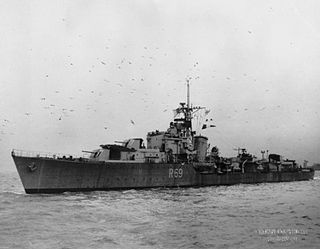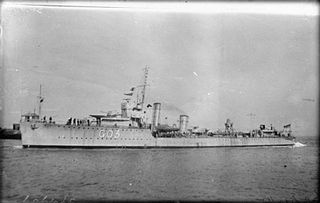
HMS Rotherham was an R-class destroyer of the British Royal Navy during the Second World War, named after Captain Edward Rotheram, who commanded HMS Royal Sovereign during at the Battle of Trafalgar in 1805. Rotherham was completed in 1942 and equipped as a flotilla leader, having slightly reduced armament to allow for the increased complement and working space required. Decommissioned in 1945, the ship was sold to India in 1948, serving as INS Rajput (D141) until 1976, when she was scrapped.

HMS Broke was a Thornycroft type flotilla leader of the Royal Navy. She was the second of four ships of this class that were ordered from J I Thornycroft in April 1918, and was originally named Rooke after Rear Admiral Sir George Rooke of the Dutch Wars and the Battle of Vigo Bay.

HMS Roebuck was an R-class destroyer of the British Royal Navy that saw service during World War II. She was the fifteenth ship to carry this traditional ship name, after a small deer native to the British Isles, which was used as far back as the reign of Queen Elizabeth I.

HMS Ulysses was a U-class destroyer of the British Royal Navy that saw service during World War II. She was later converted into a Type 15 fast anti-submarine frigate, with the new pennant number F17.

HMS Opportune was an O-class destroyer of the Royal Navy. She was ordered from John I. Thornycroft & Company, Woolston on 3 September 1939 for the 1st Emergency Flotilla. She was commissioned on 14 August 1942. She was the second Royal Navy ship borne Opportune.

HMS Vortigern was a V-class destroyer of the Royal Navy. She served in both World Wars, and was sunk in 1942.

HMS Kempenfelt was a W-class destroyer flotilla leader of the Royal Navy that served in the Second World War. She was the second destroyer of her name to have served in the war; the first Kempenfelt was transferred to the Royal Canadian Navy in October 1939 and renamed HMCS Assiniboine.

HMS Tetcott was a Type II British Hunt-class destroyer built for the Royal Navy during World War II. She was the only Royal Navy ship to be named after the Tetcott fox hunt.

HMS Anthony was an A-class destroyer of the Royal Navy. She served in the Second World War.

HMS Loch Arkaig was a Loch-class frigate of the British Royal Navy, named after Loch Arkaig in Scotland. The ship was ordered from Caledon Shipbuilding & Engineering Company, Dundee, Scotland, on 2 February 1943, and laid down on 1 November 1943. Launched on 7 June 1944, the ship was commissioned on 1 November 1945, and completed on 17 November. Unlike the rest of the class Loch Arkaig was fitted with Parsons single reduction geared turbines, rather than 4-cylinder vertical triple expansion reciprocating engines. The ship served in the Home Fleet until laid-up and put into Reserve in 1952, and was sold for scrapping in 1959.

HMS Carysfort was a C-class destroyer of the Royal Navy. She was ordered in 1941, originally under the name HMS Pique.

HMS Mendip (L60) was a Hunt-class destroyer of the Royal Navy. She was a member of the first subgroup of the class. The ship is notable for seeing service in the navies of three other nations after her use by the Royal Navy. She saw service in the Second World War and later as an Egyptian Navy ship in the Suez Crisis. She was captured in battle on 31 October 1956 by the Israeli Navy and re-commissioned as INS Haifa (K-38).

HMS Brecon was a Hunt-class destroyer of the Royal Navy that saw service in World War II, one of two ships in the fourth subgroup of the class, built to a radically different design from other ships in the Hunt class.

The third HMS Windsor (D42) was a W-class destroyer of the British Royal Navy that saw service in the final months of World War I and in World War II.

The second HMS Wivern, was a Modified W-class destroyer of the British Royal Navy that saw service in World War II.

HMS Zodiac was a Z-class destroyer of the Royal Navy built in 1944 by John I. Thornycroft, Woolston. She served during the Second World War, participating in operations in the North Sea and off the Norwegian coast, before taking part in some of the Arctic convoys. She spent a further ten years in Royal Navy service after the end of the war, before being sold to the Israeli Navy, which operated her as INS Yaffo. She saw action during the Suez Crisis in 1956, attacking Egyptian ships and was still active by the outbreak of the Six-Day War in 1967.

HMS Myngs was a Z-class destroyer of the Royal Navy built as a flotilla leader by Vickers-Armstrongs, High Walker. She served in the Second World War, taking part in operations in the North Sea and off the Norwegian coast, before taking part in some of the Arctic convoys. She spent a further ten years in Royal Navy service after the end of the war, before being sold to the Egyptian Navy, which operated her as El Qaher. She was sunk in an Israeli air attack on 16 May 1970.

HMS Wager was a W-class destroyer of the Royal Navy that served in the Second World War. She was sold to the Yugoslav Navy in 1956, renamed Pula, and scrapped in 1971.

HMS Obedient was an O-class destroyer of the Royal Navy. She was built by William Denny and Brothers of Dumbarton, between 1940 and 1942. During Warship Week in 1942 she was adopted by the civil community of Lymington, United Kingdom. She was scrapped in 1962.

HMS Wilton was a Type 2 Hunt-class destroyer of the Royal Navy that served in the Second World War.




















